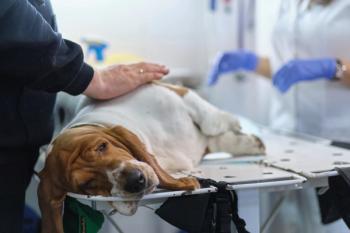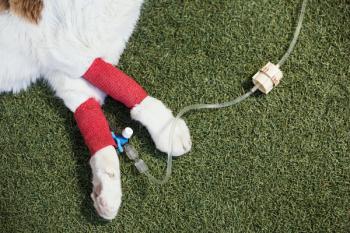
Thymoma in an 11-year-old dog: Clinical pathology perspective
Dr. Lisa Viesselmann provides the clinical pathology perspective on this thymoma case.
Dr. Lisa ViesselmannCytology is an important tool in the initial evaluation of cranial mediastinal masses in dogs, and the primary goal of this evaluation is to help distinguish between thymomas and lymphomas. Thymic and branchial cysts are less common causes of cranial mediastinal masses in dogs, and cytologic samples from these lesions are often of low cellularity and display features consistent with cystic fluid. Thymomas may also contain cystic areas; however, aspirates or impression smears from solid areas of the mass often provide highly cellular samples.
There are multiple subtypes of thymoma that can be identified histologically. But cytologically, most thymomas consist predominantly of small, mature lymphocytes, and aspirates may appear similar to those of normal lymph nodes (Figure 1).1 Low numbers of intermediate to large lymphocytes may also be present. Despite the predominance of small lymphocytes observed cytologically, the epithelial cells (epitheliocytes) are the neoplastic population, and their presence in a sample confirms a diagnosis of thymoma.
Figure 1. Representative image of a fine-needle aspirate from a thymoma in a dog (not the patient in this case). Nucleated cells consist predominantly of small lymphocytes with scant cytoplasm and small, round, condensed nuclei. Low numbers of intermediate to large lymphocytes (long arrows) and occasional individual mast cells (short arrows) are also observed (modified Wright's stain; 500x). (Image courtesy of Bente Flatland, DVM, MS, DACVIM, DACVP.)Thymic epitheliocytes may be observed individually or in variably sized cohesive clusters, and if they are present, it is often in low numbers.1 Epitheliocytes tend to exhibit variable morphology and often lack striking features of malignancy. For these reasons, cytologic differentiation from other cell types (e.g. macrophages) can be challenging. The epithelial cell clusters may appear similar to aggregates of epithelioid macrophages with indistinct cell borders and high nuclear-to-cytoplasmic ratios, or the cells may have distinct oval-to-polygonal cell outlines with more moderate nuclear-to-cytoplasmic ratios and moderate amounts of pale blue cytoplasm (Figure 2).2
Figure 2. High-power view of a thymoma in the dog from Figure 1 (not the patient in this case), showing a small cluster of epithelial cells with indistinct cell borders, high nuclear to cytoplasmic ratios, small amounts of pale basophilic cytoplasm, and single prominent nucleoli. Identification of these cells in a cranial mediastinal mass aspirate is diagnostic for thymoma (modified Wright's stain; 1,000x). (Image courtesy of Bente Flatland, DVM, MS, DACVIM, DACVP.)Additionally, variable numbers of well-differentiated (often highly granulated) mast cells may be observed in cytologic samples from canine thymomas (Figure 3). Mast cells are often present in excess of what would be expected in a normal or reactive lymph node, and it is important to avoid misinterpreting them as a neoplastic cell population.2
Figure 3. Large numbers of individual, well-differentiated mast cells (short arrows) are observed in this aspirate of a thymoma from the dog in Figures 1 & 2 (not the patient in this case). Low numbers of epitheliocytes (long arrow) are also present on a background consisting predominantly of small lymphocytes (modified Wright's stain, 1,000x). (Image courtesy of Bente Flatland, DVM, MS, DACVIM, DACVP.)Occasionally, small amounts of pink extracellular material may be observed in aspirates of thymomas. It is suspected that this material represents collagen from the tumor capsule or from intralesional fibrous septa. It is important diagnostically to differentiate this material from colloid, because a thyroid tumor could present in a similar anatomic location.1
In contrast to thymoma, aspirates from a thymic or mediastinal lymphoma are expected to exhibit the same cytologic features as lymphoma in any other anatomic location, with the predominant cell type being a monomorphic population of neoplastic lymphocytes. Thymic lymphomas are commonly large cell lymphomas, in which the lymphocyte nuclei are larger than the diameter of a neutrophil, with dispersed chromatin and often visible nucleoli (Figure 4).2 However, small- or intermediate-cell lymphomas are also possible, and the immunophenotype of the lymphoma (T or B cell) is variable.3 In cytologic samples of lymphoma, epitheliocytes are not present and increased numbers of mast cells are not observed.
Figure 4. Fine-needle aspirates from a large cell lymphoma in another dog (not the patient in this case) shows a monomorphic population of intermediate to large lymphocytes with dispersed chromatin and single to multiple prominent nucleoli. The lymphocyte population is more homogeneous than the population is in Figure 1, and only rare small lymphocytes are observed in this sample (arrow) (modified Wright's stain; 500x magnification).
Flow cytometry
Flow cytometry is another useful tool that can help in the diagnosing of thymoma if cytology is not definitive. Flow cytometry is an immunophenotyping method that relies on the presence of certain surface proteins (antigens) on the cell population of interest. Antibodies to specific surface antigens are added to the patient sample (e.g. tissue aspirate, blood), and these antibodies are often fluorescently tagged. As the cells in the sample flow through the analyzer, the instrument detects the fluorescence emitted by antibodies bound to their specific antigens.4
Most laboratories that perform this test offer a basic panel of antibodies against canine lymphoid markers, including B lymphocytes (CD21), T lymphocytes (CD3, CD5), and T lymphocyte subsets (CD4 [helper T cell], CD8 [cytotoxic T cell]). Flow cytometry requires the cells to be suspended in fluid (not fixed on glass slides), and thus, a fresh needle aspirate sample from the mass is needed for this test.
Although the lymphocytes present in a thymoma are benign, they have a unique immunophenotype that allows for their identification. The thymus is the normal site of T lymphocyte maturation, and thymic epitheliocytes are directly involved in this process. In an active thymus in a young animal, most of the T lymphocytes are positive for both CD4 and CD8 surface markers. As they go through the differentiation process, they ultimately downregulate one of the markers to become either CD4+ or CD8+ T lymphocytes that are then released into peripheral circulation.5 Thus, the thymus (normal or neoplastic) is the only site where double-positive CD4+CD8+ T lymphocytes are found. The presence of more than 10% T lymphocytes expressing both CD4 and CD8 in a mediastinal mass aspirate has been identified as a diagnostic threshold with 100% specificity for thymoma.3
In the patient in this case, 21% of the small lymphocytes in the mass aspirate were CD4+CD8+. In contrast, most of the lymphocytes in a T cell lymphoma in the thymus would be expected to express either CD4 or CD8 but not both. CD4-CD8- T cell lymphomas and B cell lymphomas have also been less commonly reported in canine mediastinal masses.3
References
1. Valenciano AC, Cowell RL. The lung and intrathoracic structures. In: Cowell and Tyler's diagnostic cytology and hematology of the dog and cat. 4th ed. St. Louis: Elsevier, 2014.
2. Raskin RE, Meyer DJ. Hemolymphatic system. In: Canine and feline cytology: a color atlas and interpretation guide. 3rd ed. St. Louis: Elsevier, 2016.
3. Lana S, Plaza S, Hampe K, et al. Diagnosis of mediastinal masses in dogs by flow cytometry. J Vet Intern Med 2006;20:1161-1165.
4. Valenciano AC, Cowell RL. Flow cytometry. In: Cowell and Tyler's diagnostic cytology and hematology of the dog and cat. 4th ed. St. Louis: Elsevier, 2014.
5. Burton AG, Borjesson DL, Vernau W. Thymoma-associated lymphocytosis in a dog. Vet Clin Pathol 2014;43:584-588.
Newsletter
From exam room tips to practice management insights, get trusted veterinary news delivered straight to your inbox—subscribe to dvm360.





